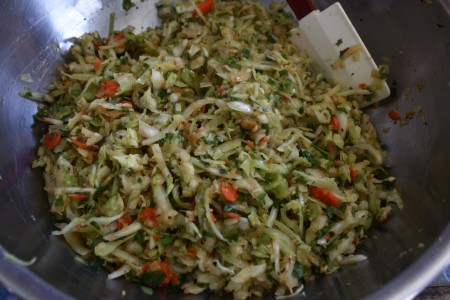 Working in the Shala kitchen reawakened and expanded upon an interest that was first awakened by what was then a scarce resource in my life: booze. My first experiments in fermentation resulted in a glass pipe bomb that embedded domino sized triangles of glass into the walls of my bathroom, and peach mush in every conceivable corner of the room. Years later, upon entering the kitchen at Circle Yoga Shala as an apprentice and making the first batches of kimchi and sauerkraut, that interest was re-awakened with a much broader perspective.
Working in the Shala kitchen reawakened and expanded upon an interest that was first awakened by what was then a scarce resource in my life: booze. My first experiments in fermentation resulted in a glass pipe bomb that embedded domino sized triangles of glass into the walls of my bathroom, and peach mush in every conceivable corner of the room. Years later, upon entering the kitchen at Circle Yoga Shala as an apprentice and making the first batches of kimchi and sauerkraut, that interest was re-awakened with a much broader perspective.
Fermentation is magical to me. Billions of microscopic life forms naturally present in the air and on the peels and skins of foods work to transform sugars and carbohydrates into acids and alcohols that preserve and even improve the nutritional profile of the original ingredients. The range of traditional foods that are fermented is astonishing, yet logical when the absence of modern conveniences like refrigeration are taken into consideration. From yogurt and cheese to sauerkraut, chutney, sourdough, kombucha, and even meats, modern society would probably not be what it is without the spontaneous transformation of perishable food from fresh to preserved through the action of yeasts and sugar loving bacteria. This transformative magic bears a striking resemblance to the nature of the work I undertook as an apprentice, and is yet another reminder of how integral transformation is to our reality.
With the industrialization of the food industry, much of the knowledge of fermenting food and beverage has been forgotten. Now, there’s an exploding interest in the huge variety of consumables that can benefit from fermentation. The Shala kitchen is one hotspot of activity, putting out delicious cabbage ferments, breads, condiments, and kombucha on a regular basis. It’s not difficult to get started with fermentation, and will provide an endless source of amazement and tasty delights. For a quick introduction, swing by the Shala and spend a few days in the kitchen. More than likely, you’ll not only go home with a wealth of knowledge and enthusiasm for traditional foods, but starters for kombucha, sourdough, and even kraut if you’re lucky.
The following is a basic outline of the fermenting cultures you’ll likely find at the Shala on any given day:
Grain or legume staple: Sourdough (pancakes, waffles, bread), dosa
Chutney and condiment: Fruit chutneys, pepper relishes
Lactofermented vegetables: Pickles and other canned preserves, sauerkraut or kimchi.
Kombucha
Below is a recipe for the super healthy Indian staple, dosa. These are gluten free, lactofermented, and make for a delightful breakfast, snack, or side. The batter can be refrigerated for days and simply gets more fermented as the days pass. Give it a shot and let us know what you think.
Happy fermenting!
-Michael
Dosa Recipe
I prefer to list recipes in ratios where possible, in order to discourage the practice of recipe cooking. Recipes are useful as guidelines but should not be unnecessarily relied upon training wheels.
2 Parts Rice (preferably brown)
1 Part bean (lentil, mung, chickpea)
A few tablespoons of Whey (Strain unpasteurized yogurt in paper towels or cheese cloth over sieve)
Water for soaking
Preparing Batter
Soak the rice and beans overnight in separate containers with a tablespoon or two of whey.
In the morning, drain and reserve soaking liquid, and process beans into coarse paste, for about 3-5 min. Do the same with the rice, adding a splash of water when the paste thickens too much. Process for about 3-5 min, until the rice forms a cohesive paste that just flows in the processor.
Combine in big, preferably stainless steel bowl. Mix in a few more tablespoons of whey, cover with plastic wrap, and allow to ferment overnight in warm (80°F + place).
To Cook
Thin batter to pancake batter consistency and stir up. Should be filled with air bubbles, light and fluffy and have a distinct, sour smell.
Grease a nonstick pan with a bit of ghee and allow pan to get medium hot. Ghee should not yet be smoking (matters less in Teflon coated pan). Pour in 1/2 cup of batter, spread with rubber spatula, and allow bubbles to form as with “regular” pancakes. Flip, cook for a few more minutes, and serve with savory sauce (garlic yoghurt, curry yoghurt).
Works very well in lightly greased waffle iron.
Optional: Extra Savory Version
Sautee 1 finely chopped onion with salt and garlic. Cool and add to dosa batter before making pancakes.
Indispensible Reference Resources for Fermentation:
Wild Fermentation by Sandor Katz
Nourishing Traditions by Sally Fallon
